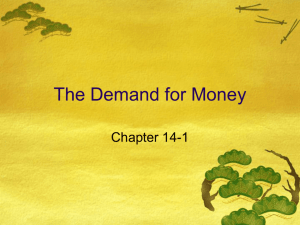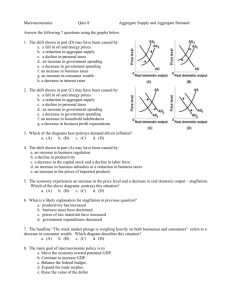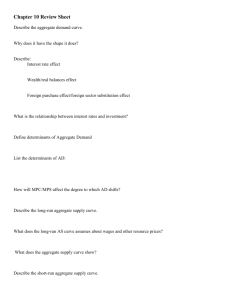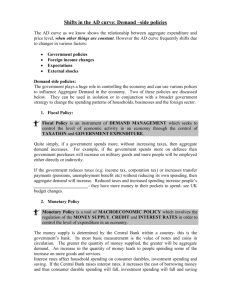Aggregate Demand and Supply
advertisement
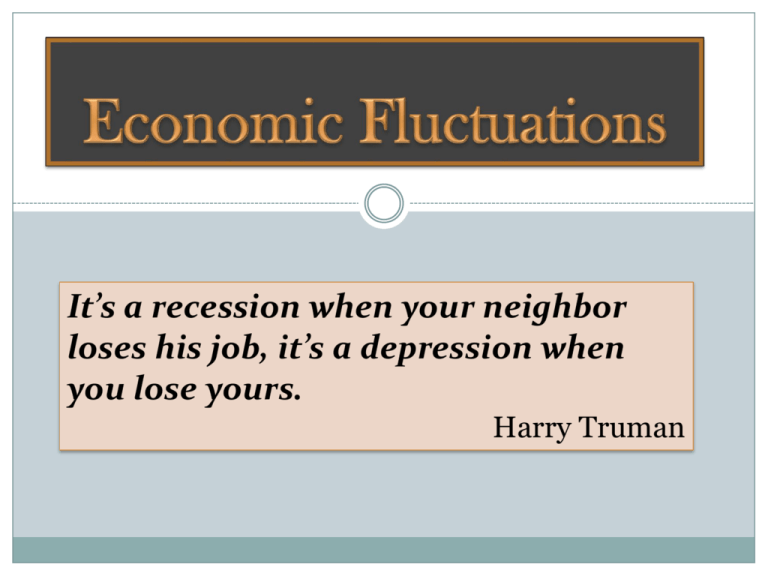
It’s a recession when your neighbor loses his job, it’s a depression when you lose yours. Harry Truman Learn about aggregate demand and the factors that will affect it Analyze aggregate supply and the factors that influence it Study the economy’s equilibrium and how it differs from its potential Examine Canada’s historical record of economic growth. What determines the connections among inflation, unemployment, and levels of spending and real output in the Canadian economy? In the economy as a whole, we see the relationship between the general price level and total spending in the economy, which is known as : Aggregate Demand Aggregate Demand Curve Aggregate Demand Schedule Price Level Real GDP Point on (1997, Graph $ billions) a 650 200 b 700 160 c 750 120 Price Level (GDP deflator, 1997 = 100) Aggregate Demand Curve 200 160 120 a b 80 c 40 0 650 700 AD 750 Real GDP (1997 $ billions) Relationship between the general price level and total spending in the economy expressed on a graph. 800 Two factors cause the aggregate demand curve to be downward sloping: The wealth effect that higher prices decrease the real value of financial assets and decrease consumption, since households feel poorer than normal. The foreign trade effect means that higher prices decrease exports and increase imports. What causes changes to the aggregate demand?? Remember spending has 4 components: An increase in spending causes a rightward shift in the curve A decrease in spending causes a leftward shift in the curve Disposable Income: Consumer spending is the most significant determinant of disposable income in the entire economy. The economy’s DI changes as a result of population changes, as well as DI/household. Therefore, when DI rises, then there is a rise on consumer spending, adding to total expenditures, and shifting the aggregate demand curve to the right. Wealth: Consists of real (houses and appliances )and financial assets (stocks and bonds). Eg: if the stock prices increase, a person owning some stocks is going to experience a real gain in wealth, resulting in a greater likelihood of spending more of their disposable income. Aggregate demand will increase, and the curve will shift to the right. Consumer Expectations: Consumer expectations influence the demand for products. If there is higher consumer spending then the aggregate demand increases, and aggregate demand curve shifts to the right. Interest Rates: People often buy durable goods, such as cars and furniture, if the real interest rate falls, consumers are more likely to borrow to pay for big items. Consumer spending rises and the Aggregate demand curve shifts to the right. Investment Demand Curve 12 a Real Total Point on Projects Interest Investment Graph Undertaken Rate (%) (1997 $ billions) 12 8 4 0 30 60 a b c -A, B A, B, C, D Real Rate of Return and Real Interest Rate (%) Investment Demand Schedule b 8 c 4 A 0 B C D1 D 30 60 Investment (1997 $ billions) In the investment demand curve, it’s the relationship between the interest rate and investment and depends on the real rate of return and the real interest rate Business Expectations: If businesses anticipate that profits will increase, the investment demand curve shifts to the right, thereby causing an increase in the aggregate demand. If a rise occurs in Government purchases Eg: Highway Construction Aggregate Demand increases Foreign Incomes If incomes increase in foreign countries, then its likely that the citizens of that country will purchase more products as a result – their own and those from other countries. Canadian exports increase, thereby increasing Canada’s aggregate demand. Exchange Rates It’s the value of one nation’s currency in terms of another currency. The impact of exchange rates on prices, are if the Canadian dollar increases in value, then the net exports fall causing aggregate demand to decrease. While the reverse occurs, when the Canadian dollar drops in value then the net exports rise increasing aggregate demand. Brief Summary Changes in the Aggregate Demand are caused by: Consumption Investment Government Purchases Net Exports. Economic Fluctuation Part 2 Aggregate Supply Review -Wealth effect:when the price decrease,household feel richer,then they may buy more,the consumption will increase -Foreign trade effect: lower prices-->increase exports-->decrease imports -Aggregate Demand : the relationship between general price level and total spending in the economy -Aggregate demand factors: C+I+G+Nx = GDP Consumption:Disposable income,Wealth,Consumer expectation,Interest Rent Investment:interest rate,business expectations Government Purchase Net Exports:foreign incomes,exchange rate Aggregate Supply Aggregate Supply: the relationship between price level and real output in the economy Aggregate Supply Curve : The slope of the total supply curve is upward sloping Factors that can change in Aggregate Supply Curve In Short run(potential output stays constant) : Aggregate Supply Curve Price Level (GDP deflator, 1997 = 100) -Input price 240 AS d 200 c 160 b 120 a Potential Output 80 40 0 750 775 800 825 850 900 Real GDP (2007 $ billions) Factors that can change in Aggregate Supply Curve In Long run(potential output is variable): -Resources supplies -Government policies Aggregate Supply Curve AS0 Price Level (GDP deflator, 1997 = 100) -Productivity AS1 240 200 160 120 40 0 New Potential Output Original Potential Output 80 650 675 700 725 750 800 Real GDP (1993 $ billions) Shifting to Rightward In short run: - a fall in wages - a fall in raw material prices In Long run: - more labour supply,capital stock,land,entrepreneurship - an increase in productivity - lower taxes - less government regulation Shifting to leftward In Short run: -a rise in wages -a rise in raw material prices In Long run: - less labour supply,capital stock,land,entrepreneurship - a decrease in productivity - higher taxes - more government regulation Part 3 Aggregate Demand and Supply Aggregate Demand and Supply - Inventory Changes - Results of an inventory increase - Results of an inventory decrease - The role of unplanned investment Injections and withdrawals - Investment and Saving - Government purchases and taxes - Exports and Imports - Total injections and withdrawals Equilibrium versus Potential Output Recessionary Gaps Inflationary Gaps Labour productivity Business cycles Definitions Expansion: A sustained rise in the real output of an economy Contraction: A sustained fall in the real output of an economy Business cycle: The cycle of expansions and contractions in the economy Peak: The point in the business cycle at which real output is at its highest Effects of a contraction Recessions and Depressions Recessions: A decline in real output that lasts for six months or more Depression: A particularly long and harsh period of reduced real output Trough: The point in the business cycle at which real output is at its lowest The highest output occurs at a peak in the business cycle. From this point, the economy contracts, so aggregate demand decreases. Consumer and business expectations magnify the downward trend. The lowest output occurs in a trough in a business cycle. From this point, the economy expands, so aggregate demand increases. Expectations magnify the upward trend. --- THE END---


